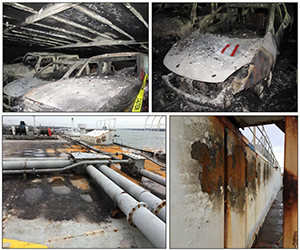Investigators say an electrical fault in a vehicle likely started a fire aboard a U.S.-flagged car carrier in the English Channel, causing $700,000 in damage to the ship.
The fire aboard the 623-foot Honor started in a top-level cargo deck at about 0300 on Feb. 24, 2017. Roughly 40 minutes later, crew activated a fixed carbon dioxide system to extinguish the flames. One crewmember suffered a leg injury during firefighting.
National Transportation Safety Board (NTSB) investigators traced the fire to a fault in a starter motor solenoid in the suspect vehicle. The make and model of the vehicle were not identified.
“Preliminary testing of this scenario confirmed that a fault within the solenoid could cause ignition of the insulation and covering on the adjacent wiring,” the agency said in an accident report released in mid-March.
The incident aboard Honor was similar to a June 2015 fire aboard the U.S.-flagged car carrier Courage. In that case, a 2002 Ford Escape caught fire in a lower cargo hold. The source of the fire was traced to a known defect subject to a manufacturer’s recall. The incident caused more than $100 million in damage to the ship and cargo.
The 22-year-old Honor is owned by Fidelio Limited Partnership and operated by TOTE Services Inc. TOTE did not respond to a request for comment.
Honor left Southampton, England, for Baltimore, Md., at about 2230 on Feb. 23 loaded with new vehicles bound for dealer lots, military vehicles and personal vehicles owned by U.S. military or government personnel working overseas.
The ship encountered rough seas and gale-force winds soon after departure. At 0302, some four and a half hours into the voyage, a pre-warning alarm indicated a problem on the garage deck located aft of the crew accommodation space. A full alarm went off soon afterward.
The AB sent to investigate noticed smoke and fire upon opening a garage deck door. He notified the bridge, and the second mate alerted the captain and chief mate. The AB then reported the space was inaccessible from the mid-deck forward.
“The master and chief mate met at the entrance to the forward door to the garage. Upon opening the door, they could see thick white smoke farther back in the compartment,” the report said.
The master returned to the bridge and ordered the general alarm sounded. Meanwhile, the second mate and chief mate put on firefighting gear and attempted to fight the flames with dry chemical extinguishers. The chief mate soon realized the space was inaccessible.
Some crewmembers cooled the boundary around the affected area while others conducted checks to make sure no one was inside the garage deck. At 0339, three minutes after a final muster, the master ordered the CO2 system deployed.
After activating the CO system, crewmembers checked for hot spots and other signs the fire was still burning but found none. Later, crew wearing protective equipment and self-contained breathing apparatuses inspected the space.
Honor returned to Southampton about 20 hours after the fire. Hours later, it shifted to an anchorage to ventilate affected spaces.
Fire investigators traced the origin to the port side of the garage deck. They later removed wiring and other components from damaged vehicles. Lab tests allowed the NTSB to zero in on the personal vehicle and its starter motor solenoid.
Honor required nearly $700,000 in repairs. The amount of damage to vehicles on the ship was not released.

